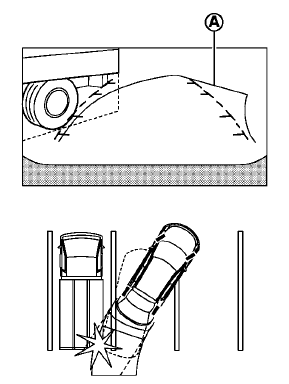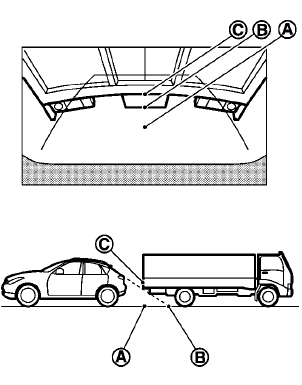Difference between predictive and actual distances

Backing up on a steep uphill
When backing up the vehicle up a hill, the distance guide lines and the vehicle width guide lines are shown closer than the actual distance.
For example, the display shows 3 ft (1 m) to the place A , but the actual 3 ft (1 m) distance on the hill is the place B . Note that any object on the hill is viewed in the monitor further than it appears.

Backing up on a steep downhill
When backing up the vehicle down a hill, the distance guide lines and the vehicle width guide lines are shown further than the actual distance.
For example, the display shows 3 ft (1 m) to the place A , but the actual 3 ft (1 m) distance on the hill is the place B . Note that any object on the hill is viewed in the monitor closer than it appears.

Backing up near a projecting object
The predictive course lines A do not touch the object in the display. However, the vehicle may hit the object if it projects over the actual backing up course.

Backing up behind a projecting object
The position C is shown further than the position B in the display. However, the position C is actually at the same distance as the position A . The vehicle may hit the object when backing up to the position A if the object projects over the actual backing up course.
See also:
How to use STATUS button
You can check information related to the audio,
climate control system, fuel consumption and
navigation system (if so equipped) by pushing
the STATUS button repeatedly. ...
Entry/exit function (for Hardtop models)
This system is designed so that the driver’s seat
and steering column will automatically move
when the shift lever is in the P (Park) position.
This allows the driver to get into and out of the ...
Voice commands
You can use voice commands to operate various
Bluetooth® Hands-Free Phone System features
using the NISSAN Voice Recognition system.
For more details, see “NISSAN voice recognition
system (mo ...
